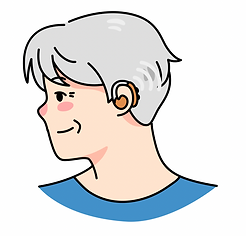
Hearing Aids: What to Know
You’re not alone. Nearly 29 million American adults could benefit from wearing hearing aids—but only about 16% of people aged 20 to 69 actually use them. That means most people who could hear better, don’t.
So, what’s holding people back?
When over-the-counter (OTC) hearing aids were approved, three key barriers were identified:
-
Cost
-
Concerns about stigma or how they’ll feel
-
Fear that hearing aids won’t help enough to be worth it
Let’s break those down and see what hearing aids can do—and how to make them work for you.
Why Hearing Aids Matter
Hearing loss doesn’t just affect your ears—it affects your brain, your energy, your confidence, and your quality of life.
When you can’t hear clearly, your brain has to work extra hard to fill in the gaps. That mental strain adds up and can lead to fatigue and frustration. Over time, untreated hearing loss may contribute to social withdrawal, cognitive decline, and other health issues.
The sooner you treat hearing loss, the better.
Your brain’s ability to process sound fades if it goes unused, so waiting can make it harder to adapt to hearing aids later.
Hearing aids help by:
-
Improving speech clarity, not just volume
-
Reducing background noise
-
Offering features like Bluetooth and direct audio streaming
Even if hearing aids aren’t right for you, strategies and tools exist to help you communicate better. An audiologist can help figure that out.
How Hearing Aids Work
All hearing aids have three main parts:
-
Microphone – picks up sound
-
Amplifier – makes it louder and clearer
-
Speaker – sends the sound into your ear
Newer hearing aids are smart. They can adjust automatically based on your environment and help you focus on the person talking—even in a noisy room.
If you have hearing loss in both ears, two hearing aids can give you more natural sound and help you locate where sounds are coming from.

Getting the Right Fit
Hearing aids aren’t one-size-fits-all. They come in different styles and sizes:
-
Behind-the-Ear (BTE): Worn behind the ear with a tube leading to a custom earmold
-
Mini BTE or Receiver-in-the-Ear (RITE): A slimmer, less noticeable version
-
Receiver-in-Canal (RIC): A speaker in the ear for more natural sound
-
In-the-Ear (ITE): Fills part or most of the outer ear
-
In-the-Canal (ITC) / Completely-in-the-Canal (CIC): Smaller, custom fit
-
Invisible-in-the-Canal (IIC): Sits deep in the canal, almost invisible
Some models come with telecoils, which let you connect directly to public sound systems (like in theaters or churches). These features are often not available in the tiniest models.
An audiologist or licensed dispenser will help you find the right fit and make adjustments so it stays comfortable and secure.
Adjusting Takes Time
Hearing aids don’t work like glasses—you don’t put them on and hear perfectly right away. Your brain needs time to relearn how to hear. You’ll likely go through a trial period (usually 30–60 days) to get used to your devices and decide if they’re a good match.
That’s normal. Be patient. You’re re-training your brain, and that takes some time.

Hearing Aid Maintenance
Taking care of your hearing aids helps them last longer and perform better.
Daily:
-
Wipe with a soft, dry cloth
-
Check for earwax or moisture in the receiver and tubing
Weekly:
-
Clean domes or earmolds with a slightly damp cloth
-
Replace silicone domes if needed
-
Consider a drying kit if you sweat a lot
Monthly or as needed:
-
Replace wax guards and filters
-
Check for loose or worn-out parts
-
Schedule tune-ups with your audiologis
Avoid water, alcohol, hairspray, or lotion near your devices. Always store them in a dry case or charger—losing a hearing aid is a costly hassle!
Cost & Trial Periods
Prescription hearing aids typically range from $2,000 to $4,000 per ear.
Most come with a trial period—but be aware that for first-time users, it can take longer to figure out what you really need.
Over-the-Counter Hearing Aids (OTC)
You can now buy certain hearing aids without a prescription, either online or in stores.
OTC hearing aids are best for adults with mild to moderate hearing loss. If you:
-
Find speech sounds muffled
-
Struggle in groups or noisy places
-
Turn up the TV often
-
Ask people to repeat themselves…
...you might benefit from OTC aids.
BUT—if you have trouble hearing in quiet environments, or can’t hear loud sounds, it’s time to see an audiologist.
OTC hearing aids usually cost $500–$3,000. They often come with self-guided setup, online help, or retail support. Some people find them easy to adjust; others need more guidance.
Bonus: AirPods as Hearing Aids?
Apple’s AirPods Pro 2 now include clinical-grade hearing aid features. You can:
-
Take a hearing test with your iPhone
-
Upload your audiogram
-
Let the AirPods auto-adjust for your needs
They last about 6 hours in hearing mode, with fast recharging.

.png)
